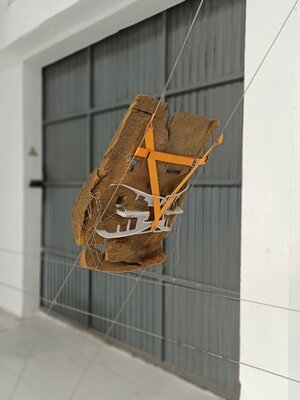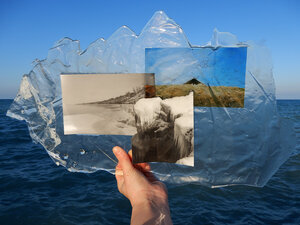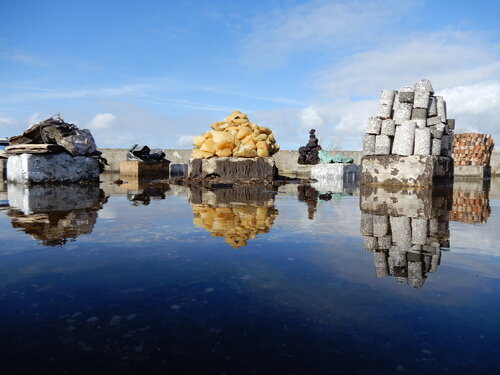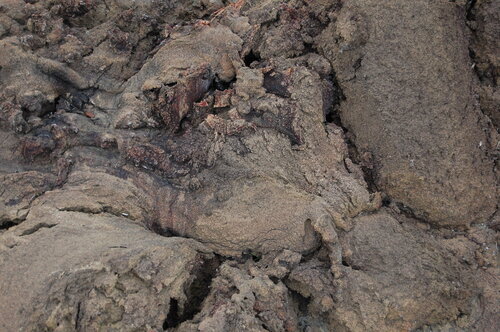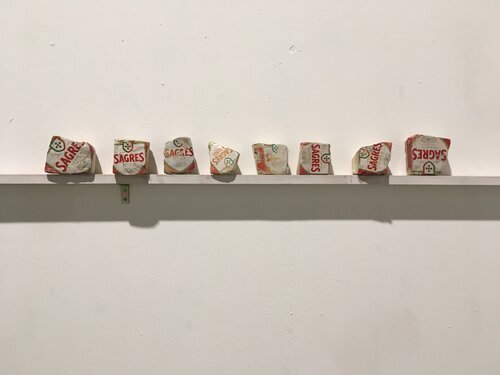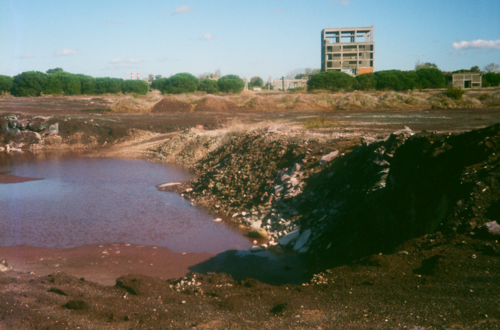LONG RANGE STUDIO VISITS
Maria Positano and Nicole Shaver
In this conversation as part of our Long Range Studio Visits series we introduce Maria Positano and Nicole Shaver. Both artists share an intense relationship with the environment and a practice that works with and alongside the landscape. In this article they discuss their explorations of the restricted section of the industrial park at PADA, how they processed the finds and how it has informed their respective practices moving forward.
Maria Positano, “It’s like You were never really Here”, found car seat, wire cable, ratchet straps, printed text on yellow vinyl, 350 x 563 x 50 cm, (from Where you Are Not, shown at PADA Studios, October 2019)
Maria Positano’s practice resides within a strand of contemporary thinking which explores process-led and concept driven research, aimed at addressing current enquiries around making sculpture today. Through careful consideration of presentation and curation of objects in space, her work aims at recreating a landscape in which to explore concepts relative to personal and universal histories of meaning and relationships between the object and the body in space. Individual’s desires are explored within physical and spatial performed actions such as collecting, presenting, holding close.
Nicole Shaver, Sequestered, frozen-onshore, Slidescapes series, collage, 35mm photo transparencies set in resin, 2020
Nicole Shaver endeavors to understand a place by engaging fully with its material value, elevating banal human detritus and local geology to the artistic practice. Interested in the intersection between the natural and the man-made, objects that seem otherworldly she catalogues the growth of our planet. Recording this investigation of the Anthropocene through image-making she employs interdisciplinary media: installation, printmaking, photography, and sculpture. The collected specimens, historical research, and genuine spatial interaction become semiotic compasses to navigate identities of places, providing a framework that empathizes with our transitioning Earth.
Nicole Shaver, “Reflection Pool for CUF”, 2019
Nicole Shaver: Hi Maria! Nice to meet you in this online document! I can see why PADA thought we might want to chat. Based on what I can discern from your online presence, I see a similar appreciation for geological/natural processes and how to represent those materials through a studio practice. This is a focus in my work as well and I have been thinking more recently about how I approach the creative process, almost as a debunked scientist. I have a question or observational inquiry about the world and approach that answer by keeping my eyes, cameras and pockets open. Without saying too much too fast, I’ve uploaded my two projects completed during my residency at PADA, some photos from my time there and a series of resin pieces I’m developing now, I believe it was a direct result of my time exploring CUF.
Maria Positano: Hello Nicole! Nice to virtually meet you too! Yes absolutely, I really appreciate what seems to have been a shared interest in the restricted Barreiro areas and an exploration of our respective immediate encounters with it’s materiality. I really like the approach you talk about here: as being a sort of archeologist, or, as you say, ‘debunked scientist’. I specifically liked how you seemed to have been collecting, assembling and placing those found objects (presenting them once again in their environment), but shifting their nature through your application of process, “assemblage”, or “digestion”. Can you tell me a bit more about that process for you? How do you describe your relationship with these found objects? During PADA, I was extremely interested in the ways I could talk about my relationship with given stranger environments; through process, application, modification, labour, using curated assemblies as repositioning objects of interest.
I have uploaded some images from my time in PADA: object of interest, details of landscapes that captured me, and what I have done with some of the things from the land. Hope you enjoy this visual journey!
Maria Positano, detail of landscape, CUF
NS: When I am in a new place, I almost force an assimilation to the land by trying to understand my physical placement as fully as possible. Meaning approaching the same site, almost ritualistically to notice its changes and the way it can be revealed through materials found there, almost archeological cataloging.
As artists we are very much about sensory and the visual, so I gravitate towards an explanation of that place through what I can see and touch in order to depict that again later to describe that mediation of where I was.
I basically had two meditative practices during PADA, almost establishing a routine imitating a worker from the plant. I would explore the restricted area daily and create my installation, the Reflection Pool for CUF from the materials I found there. I brought my camera and backpack and would spend time observing and assembling. Sometimes there were homeless men, sometimes there were fishermen down by the bay catching, what? Octopus? Monkfish? Oh how I would love to eat in Portugal today. And then I would go to Firestation around 3, where the restaurant had been setting aside Sagres beer bottles for me to peel off their labels. I thought of all the workers who had and were having beers here, spending their lives working. I adhered them to bricks I had collected from alleyways and streets, again collecting what was below my feet.
Do you feel like your practice helps you better explain something? It's like a material essence, or a message that just needs the right decoding. How much of that is important for you to share with the viewer?
MP: I love how you talk about your relationship within given environments, I feel a great similarity with my approach as well.
Yeah absolutely, a practice is basically the way I have found to process and reflect over the practice itself, helping me to create fluid relationships between objects that respond to me (and vice versa), the way I digest environments, and internalize it’s qualities in my work.
It seems like a lot of your practice back then was intrinsically connected with the idea of a routine, a self imposed process of finding connectivity with that environment? How have you adapted your practice in the last weeks/months? Of course, our relationship with the outside has been limited after COVID 19, allowing us maybe more of an internal, intimate, routine/discovery? Would love to see some of your work in process now. I have uploaded some of the work I have been doing during isolation, which I found to be an insanely interesting moment for my practice.
I love the idea that a practice and all the movements decided within it, can be translated in a never ending process of cross referencing or reconsideration, and ever changing but constant shifts of the same visual material. The combination of all perceived experience through time and the everpresent residual elements of my material discoveries form a continuity, a process, which is at the core of my present sculptural interest.
Nicole Shaver, “Sagrado Sagres Libation”, 2019
NS: I think that actually most people have that innate puzzling, trying to figure out an answer to what it is to be present, or how to represent that ‘presentness’. --- Think people in caves blowing pigment around their hands. I think artists do this particularly well because we keep open to visuals and the sensory spikes that repeat or present themselves in precarious ways.
For instance, leaving PADA, I brought back to the US with me some tile I bought in Lisbon wrapped in a plastic bag. The souvenir is all and well, but the bag was so actually representative of the grit I felt there. I thought about it as a relic of that time, a very specific place and time and utilitarianism of it. I encased the bags in resin using gift bags as a mould, encasing them with their own form. I thought about greek amphora and pouring vessels, painted imagery showing the use of the object on which it was inscribed. What if the bag were dug up in the future, inspected to try to understand the humans that once lived there? And now of course, given current COVID events, the bags have a different kind of resonance. I didn’t intend on grocery store contexts, but the real present has a way of determining the work, and I relish in that. Most really great projects for me continue to reveal different meanings as time and outside influences change the work.
The work has almost different cooking times, some of it needs a bit of marinating. This is where I think the studio is most important, work needs to sit and ponder with the process. During all the resin pouring, I have been making assemblages, I’m calling them slidescapes, of collaged 35mm photo transparencies set in resin. In this work, I’m considering how to represent the idyllic landscape of wanderlust, a cataloging of experience in the style of a melted photo slide or a half remembered mountain peak. Does your work tend to blend across projects? How do you know when to piece off parts or how much to make whole?
MP: Yeah, definitely. My work has always developed in a kind of organic process across projects, the previous ones always influencing the next and so on. The work I have been producing for the last 7 months has been a result of a conscious focus on the creation and recreation of objects using residual materials from previous works, and the objects that I tent to collect, curate and re - propose, end up being incorporated into a visual language which talks about the making itself, if that makes sense.
Works do have different cooking time, as you say, and also different rhythms. The processes that we employ, in their immediacy or their laboriousness, create a viewing ‘rhythm’ in the work. This rhythm is also dictated by the language of things; juxtaposing old objects, valuable and labour intensive materials, new ‘trash’, ready made arranged bits of things which we find, apply and present.
I am very interested in your last question, because I never felt it was necessary to question too much the ‘piece off’ or ‘make whole’ part: I see the works as a sort of machine, where each part operates with its own agency, still all pieces create an organism, a landscape, a functional totality.
When I had the chance to go through your work, I was absolutely struck by one in particular: Catalog of Where We’ve Been, Where We’re Going zebra mussels, glass, window, oxidized nuts, fire brick, glass brick, aluminum. Can you tell me a bit more about your thinking for this work? Was also quite curious to know how it relates with works like Cornhusk Cloak, cornhusks and hot-pressed foil, or Some Kind of Way, 1,000 bricks and hot-pressed foil?
I feel that in the first instance there is almost the intention to retain or present identity, whilst in the second series, your work is about shifting or mutating that material identity into almost the absurd? How do you feel about that?
Maria Positano, “VENUS (You were born from the scum of the waters)”, 2020
NS: Yes! And this goes back to my question, I suppose, about how when a work is complete, or when it is okay to let the series dribble over into the next. When I make larger installations, like ‘Some Kind of Way,’ it is so much a process of arranging and manipulating the micro to create a whole. Inevitably, with all that hand holding, I start to appreciate the pieces for their imperfections and identify their unique qualities. So, when it came time to dismantle that installation made of 1,000 bricks, I had already moved them from place to place by hand so many times I had known intimately their weight and strength. I returned the bricks to the yard from where they were collected and let the gold bricks intermingle, maybe one day set in a wall, a gem among the rubble.
For the most part, I don’t save much but a few ‘samples’ from these installations. I have three gold bricks from this piece, one I just laid in my garden last night! A good lot of these samples are in a display case in my home, a Sagres brick, a resin chunk, glass collected from my demolished high school, cores of Icelandic rocks, an aluminum cast sponge from where my Mom lives in Florida…. All the remnants started to add up and create a material portrait of myself. ‘Where We’ve Been, Where We’re Going,’ is a play on this curiosity cabinet and some of the ways I have manipulated geologies to capture space. I suppose it's like a material scrap book of all the places I have represented.
Yes! I love the absurd. I hope for my work to have a cadence of something familiar, be convincing to illicit inspection and recall the place of which it came, or where it could be going. The piece you are working on now has this feeling, reptilian, functional and a little menacing.
MP: I think the most important and inherent part of a practice goes beyond final work, I think that mostly what is really interesting is what happens outside of the finished presented work. In fact, attempting to present through finished work the surrounding quality of one’s process, evaluations and digestions, thoughts and association; is almost a circular infinite process, like an Ouroboros endlessly eating itself. From a synthesis, or the end of a process, we create the final work; which in itself is attempting to be a reflection of the very material that needed to be shredded for the work to become final.
Sculpture for me has to do with balancing a composition between these different elements which define the making.
In a way making sculpture happens from the looking, from the action of collecting or choosing to preserve an object over the other, looking at the mundane things that surround us and in them seeing their shapes as the potential to be shifted into something totally different. My work tries to think about all this and from that place, attempts to make sculpture which strives to be the embodiment of a traced existence, or a series of moments in time. Sculpture to me is a way almost to pin drop in time, in space, creating something which is altogether yours (or you, even).
These thoughts have been informing my latest work, and are still present in the work I am making now; for example in the series VENUS (You were born from the scum of the waters), I am presenting a series of works which all seem to have been created from the same fluid one moment in process, if that makes sense. Materials seem to reference and transform into each other and merge into a coherent visual language which deals with organicity, and adaptability. All together the works I made for PADA (Where you are Not, 2019) and the VENUS series (2020), present themselves as potentially ever shifting collection of objects, relevant in that moment to represent that PinDrop situation I mentioned before. But as soon as presented in the space they are already ready to be something else, become the next moment, transmutate again.
Nicole Shaver, 35mm film, CUF, 2019
For more information and to see more examples of work visit
